Bicep Reflex Test
Biceps (C5, C6 Musculocutaneous Nerve):
1. This is most easily done with the patient seated.
2. Identify the location of the biceps tendon. To do this, have the patient flex at the elbow while you observe and palpate the antecubital fossa. The tendon will look and feel like a thick cord.
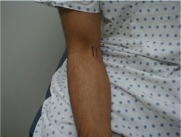
Biceps Tendon: Tendon is outlined in pen.
3. Support the arm in yours, such that your thumb is resting directly over the biceps tendon (hold their right arm with your right; and vice versa).
4. Make sure that the biceps muscle is completely relaxed.
5. It may be difficult to direct your hammer strike such that the force is transmitted directly on to the biceps tendon, and not dissipated amongst the rest of the soft tissue in the area. If you are supporting the patient’s arm, place your thumb on the tendon and strike this digit. If the arm is unsupported, place your index or middle fingers firmly against the tendon and strike them with the hammer.
6. Make sure that the patient’s sleeve is rolled up so that you can directly observe the muscle as well as watch the lower arm for movement. A normal response will cause the biceps to contract, drawing the lower arm upwards.
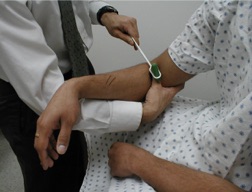
Brachioradialis Reflex Test
Brachioradialis (C5, C6 Radial Nerve):
1. This is most easily done with the patient seated. The lower arm should be resting loosely on the patient’s lap.
2. The tendon of the Brachioradialis muscle cannot be seen or well palpated, which makes this reflex a bit tricky to elicit. The tendon crosses the radius (thumb side of the lower arm) approximately 10 cm proximal to the wrist.
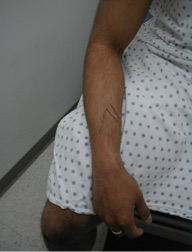 Brachioradialis Tendon: Tendon is outlined in pen.
Brachioradialis Tendon: Tendon is outlined in pen.
3. Strike this area with your reflex hammer. Usually, hitting anywhere in the right vicinity will generate the reflex.
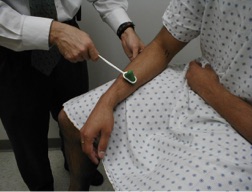
4. Observe the lower arm and body of the Brachioradialis for a response. A normal reflex will cause the lower arm to flex at the elbow and the hand to supinate (turn palm upward).
Triceps Reflex Test
Triceps (C7, C8 Radial Nerve):
1. This is most easily done with the patient seated.
2. Identify the triceps tendon, a discrete, broad structure that can be palpated (and often seen) as it extends across the elbow to the body of the muscle, located on the back of the upper arm. If you are having trouble clearly identifying the tendon, ask the patient to extend their lower arm at the elbow while you observe and palpate in the appropriate region.
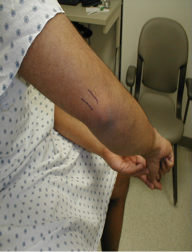
3. Gently pull the arm out from the patient’s body, such that it roughly forms a right angle at the shoulder. The lower arm should dangle directly downward at the elbow.
4. If you are certain as to the precise location of the tendon, strike this area directly with your hammer. If the target is not clearly apparent or the tendon is surrounded by an excessive amount of subcutaneous fat (which might dissipate the force of your strike), place your index or middle finger firmly against the structure. Then strike your finger.
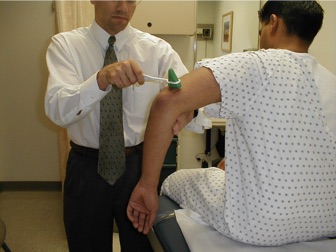
5. Make sure that the triceps is uncovered, so that you can observe the response. The normal reflex will cause the lower arm to extend at the elbow and swing away from the body. If the patient’s hands are on their hips, the arm will not move but the muscle should shorten vigorously.
